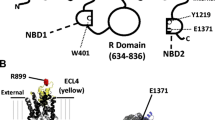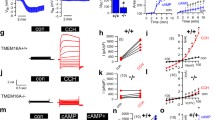Abstract.
A new family of chloride transport proteins has recently emerged. These proteins have extensive homology to a protein previously isolated from bovine tracheal epithelium that acts as a Ca2+-sensitive Cl– channel (CaCC) when heterologously expressed or when reconstituted into planar lipid bilayers. Several new members of this family have been identified in human, murine, and bovine epithelia, in addition to some other tissues, and are associated with Ca2+-sensitive conductive chloride transport when heterologously expressed in Xenopus oocytes or HEK 293 cells. The expressed current is also sensitive to inhibitors such as DIDS and niflumic acid. In addition, at least one family member acts as an endothelial cell adhesion molecule. This emerging family may underlie the Ca2+-mediated Cl– conductance responsible for rescue of the cystic fibrosis (CF) knockout mouse from significant airway disease.
Similar content being viewed by others
Author information
Authors and Affiliations
Additional information
Electronic Publication
Rights and permissions
About this article
Cite this article
Fuller, C.M., Ji, HL., Tousson, A. et al. Ca2+-activated Cl– channels: a newly emerging anion transport family. Pflügers Arch - Eur J Physiol 443 (Suppl 1), S107–S110 (2001). https://doi.org/10.1007/s004240100655
Issue Date:
DOI: https://doi.org/10.1007/s004240100655




